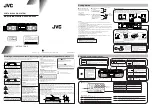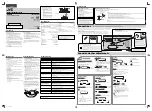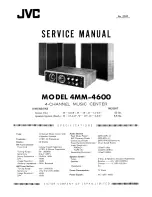
Manual-4
MQ 302S CONNECTION
Exactly
where
you install your MQ 302S into a sound
system significantly affects such things as noise, system
headroom, compressor/limiter performance and other factors
influencing overall sound quality. Both
what
and
why
you are
equalizing determines
where
you install it. We’ll leave the
when
and
who
entirely up to you.
WHAT AND WHY
Tone contouring is accomplished mainly by ear. This you
know how to do. Be careful though, not to introduce too
much boost to the bass area. Be aware that the MQ 302S is
capable of boosting signals up to 12 dB (4 times as large!)—a
level at which great care should be taken to prevent seismic
disturbances. Optimal gain setting is indicated by the +4 dBu
indicator lighting occasionally, while the OL indicator does
not light.
The MQ 302S can be used to align crossovers and flatten
speaker response. The best way to “see” what your sound
system is doing, is to use a realtime analyzer. A 1/3-octave
realtime analyzer is an accurate means for setting a 1/3-octave
equalizer properly.
WHERE
For tone contouring, the equalizer may be used at any
point in the signal chain, such as insert loops in a mixer to
equalize a single instrument, sweeten a tape recording, etc.
When an equalizer is used for acoustical correction, the
equalizer should be one of the
last
pieces of gear in front of
the amplifiers and active crossovers. Here are a few
general
guidelines useful in deciding exactly where to install the MQ
302S in the system. See Figure 1 on the next page.
Downstream of the Compressor
Since system EQ is aimed at controlling
acoustical
problems, install it
after
any compressor, which is designed to
operate on electrical program material. For one thing, the
equalizer slider settings will change in each room location,
which in turn affects the control voltage and threshold
responses of the compressor, rendering it inconsistent.
Secondly, large amounts of boost often cause tone differences
by causing some frequencies to limit or compress before
others.
Upstream of the Limiter
If a limiter is installed strictly to protect the drivers, then
install the limiter just before the power amplifiers. A good
limiter leaves the dynamics unchanged until the amplifier
reaches driver overload levels.
After any System Gain
The best configuration is: mixer, compressor/limiter,
equalizer, active crossover and power amplifier. Whenever
headroom allows, try to take all the gain at the mixer, and run
unity levels from there on. This also gives better noise
performance from the mixer. Connect the MQ 302S before
the amplifier or active crossover. Take any required line gain
before the MQ 302S. Avoid taking a lot of gain in the
crossover or power amps as this may create noise problems.
The MQ 302S operates at unity gain with the INPUT LEVEL
control at the 0 dB center detent when sliders average to
center (0 dB). You can test this with the EQ BYPASS
switch—adjust the INPUT LEVEL control so that volume
does not change when switching between ACTIVE and
BYPASS. For more information, read RaneNote 135, “Setting
Sound System Level Controls,” available from the factory or
the Rane website.
Send/Receive Loops
Mixers, mixer/preamps and the like often provide send/
receive loops for additional effects or EQ, and the MQ 302S
works well in this situation. Just be sure to keep input trim or
gain controls turned up as far as the mixer input headroom
will allow, to avoid taking excessive gain downstream and
creating noise problems.
OPERATING INSTRUCTIONS
The MQ 302S is an accurate, professional quality instru-
ment capable of precise equalization down to a fraction of a
dB. You can expect several advantages from your constant-Q
equalizer over conventional designs: Moving one slider will
not affect neighboring filters as much, so you won’t spend
time re-adjusting sliders (we call this “equalizing the equal-
izer”). You’ll be able to obtain better feedback control
without losing sound quality. All sliders maintain smooth,
consistent and accurate calibrated control over filter levels,
which is especially critical in low-profile equalizer designs.
Because of this, the overall EQ adjustment process is signifi-
cantly easier and more effective.
Equalizing a sound system by ear is a
very
difficult
process to achieve successfully, especially in a timely
manner. Although the human ear is very sensitive, it is
not
calibrated, nor consistent, and frankly the odds
against
a well
behaved, clear sound system are very great when tuned by
ear. Most people know when a sound system doesn’t sound
good, unfortunately they just can’t tell exactly
why
and
where
it’s not right.
Because of this, we strongly recommend the
use of a realtime analyzer to properly equalize your system
with the MQ 302S.
Forget everything you’ve thought about analyzers and
consider this: there’s a newer generation of analyzers which
are compact, simple, very easy to operate and surprisingly
affordable. Best of all, they can make a drastic improvement
in the overall performance of your sound system while saving
a great deal of time and effort.
A realtime analyzer helps you quickly achieve things
nearly impossible by ear: flatten speaker response, minimize
feedback, reduce room resonance and achieve accurate
crossover alignment. In most cases, simply “normalizing” or
“flattening” a sound system is a surprisingly drastic improve-
ment, but
don’t stop there
:
Remember this Rane proverb: “Look, don’t stop, and
listen.” Once you have aligned the system by
looking
at the
analyzer,
don’t stop
at this point.
Listen
to the music
program and make additional adjustments to suit your taste,
Содержание MQ 302S
Страница 7: ...Manual 7 VARIOUS XLR CABLE ASSEMBLIES ...


























